
Honeysuckle: 7 pairing ideas
Our pairing ideas
Contents
Honeysuckles are attractive climbing plants that produce spectacular and fragrant flowering. Comprising nearly 200 climbing species, they offer a palette of bright and warm colours that brighten up a shady corner, a rather dull wall, or a bush with insignificant flowering. Although the Honeysuckle (or Lonicera) planted solitary is a sight in itself, its flowering is even more enhanced in the company of other plants that help maintain a cool and shaded soil. Whether large or small, deciduous or evergreen, it easily fits into various situations: on a support with other climbers, in a bed with perennials or annuals, or even in a pot on a terrace or balcony. Perfect for a bohemian garden with a pastoral and relaxing spirit, it fills the atmosphere of summer evenings with its pleasant fragrance. Many Honeysuckles are used as climbing plants, but some also serve well as groundcover to cover a surface. Discover our 7 inspiration ideas for successfully pairing climbing Honeysuckle!
→ You can also find all our tips on planting and cultivating Honeysuckles in our comprehensive guide.
With other climbing plants
On a pergola or trellis, let a Honeysuckle climb alongside another climbing plant that flowers either at the same time as your Lonicera or at different times, depending on your preferences and needs. If you are looking for a decorative effect for almost the entire year, you could, for example, install the Japanese Honeysuckle ‘Sweet Isabel’, which produces its flowers from June to September, alongside the Clematis cirrhosa ‘Winter Parasol’, with its winter flowering white speckled with pink. In autumn, the ornamental vine Vitis coignetiae with its vibrant colours perfectly serves its decorative purpose. However, if you only wish to add more colour to your outdoor space in summer and achieve a floral cascade, you can pair your Honeysuckle with a climbing plant that flowers simultaneously: the Passionflower, the Climbing Hydrangea (Hydrangea petiolaris), the Trumpet Vine, and the Star Jasmine. Alternatively, for a spring pairing, combine the white flowers of the Akebia quinata ‘Cream Form’ with the early flowering of Lonicera caprifolium (flowering in April-May). Additionally, a wall in partial shade, dressed with the sometimes monotonous evergreen foliage of a Climbing Ivy, can be adorned with a Honeysuckle that brings life and colour back to this wall.

Lonicera caprifolia (photo Wikipedia), Hedera helix ‘Goldchild’ and Akebia quinata ‘Cream Form’
With perennials or bulbous plants
Like Clematis, Honeysuckle prefers to have its stump in the shade. This is why we recommend planting perennials at the base of your Honeysuckles. Indeed, ground vegetation provides shade and helps keep the soil cool. To highlight the flowering of your Lonicera, choose shade or part-shade perennials with interesting foliage, such as Hostas or Heucheras. There are so many options! The enchanting flowers of Columbine pair particularly well with the light and airy flowering of Honeysuckles. Install Lysimachia fortunei for orange-red foliage in autumn and Hellebores for winter flowering. Ground-cover plants like Iberis or Dead Nettle can border the front of the bed. Here and there, spring bulbs (Muscari, Tulip, Daffodils…) add a splash of colour while waiting for the other plants to bloom. Summer bulbs can also find a place in the bed, such as Lilies, Eucomis, or Tulbaghias (Tulbaghia violacea ‘Silver Lace’, Tulbaghia violacea ‘Purple Eye’).
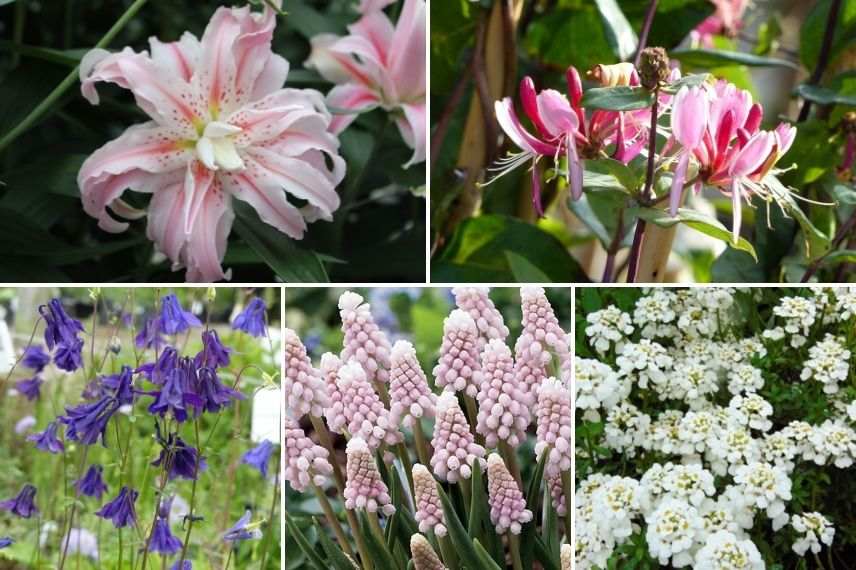
Lilium ‘Broken Heart’, Lonicera periclymenum ‘Serotina’, Aquilegia vulgaris, Muscari ‘Pink Sunrise’ and Iberis ‘Snowflake’
Discover other Honeysuckle
View all →Available in 2 sizes
Available in 2 sizes
Available in 2 sizes
Available in 1 sizes
Available in 1 sizes
Available in 1 sizes
Available in 1 sizes
Available in 2 sizes
Available in 1 sizes
Available in 1 sizes
In a container with annuals or perennials
Some Climbing Honeysuckles take up little space and can be grown in pots. Brighten your terrace or balcony with large containers in which you will plant modestly growing varieties, paired with summer-flowering annuals or perennials. For a yellow and purple scene in light shade, combine the Lonicera henryi ‘Copper Beauty’ with its warm orange-yellow flowers alongside a purple-flowered Clematis. Add annuals that prefer a semi-shaded position, such as a Lobelia (like ‘Purple Star’), a Nemesia, and Creeping Jenny ‘Goldilocks’ with its trailing habit. In the shade of a pot, highlight the Lonicera Japonica ‘Mint Crisp’ with its variegated green-yellow leaves by surrounding it with pots of perennials with beautiful foliage, such as Hostas, Carex, and Hakonechloas. In the sun, the multicoloured flowers of the small Honeysuckle ‘Chic et Choc’, a mix of pink, purple, yellow, and orange, beautifully complements a climbing Ipomoea or a Dipladenia.
→ To plant a Honeysuckle in a pot, discover our guide How to Plant a Honeysuckle in a Pot.

Clematis viticella ‘Super Nova’, Lonicera ‘Copper Beauty’, Nemesia Sunsatia ‘Anona’, Lysimachia nummularia ‘Goldilocks’ and Lobelia
Read also
How to grow Honeysuckle in a pot?With other honeysuckles
This is the classic marriage par excellence. You can combine different climbing Honeysuckles on an arch, a wooden trellis, or any other sturdy support. If a Honeysuckle has a rather short flowering period (as is the case with Tellmann’s Honeysuckle or Lonicera caprifolium), extend its decorative interest by pairing it with a variety that flowers for a longer period: Lonicera japonica ‘Sinensis’, Lonicera x italica Harlequin® ‘Sherlite’, or Lonicera heckrotii ‘Gold Flame’. However, you can also pair Loniceras with coinciding flowerings, playing with shades or contrasts of colour. For example, you can combine the bright orange-yellow trumpet flowers of Lonicera brownii ‘Golden Trumpet’ with the very pale yellow flowers of Lonicera japonica ‘Halliana’.
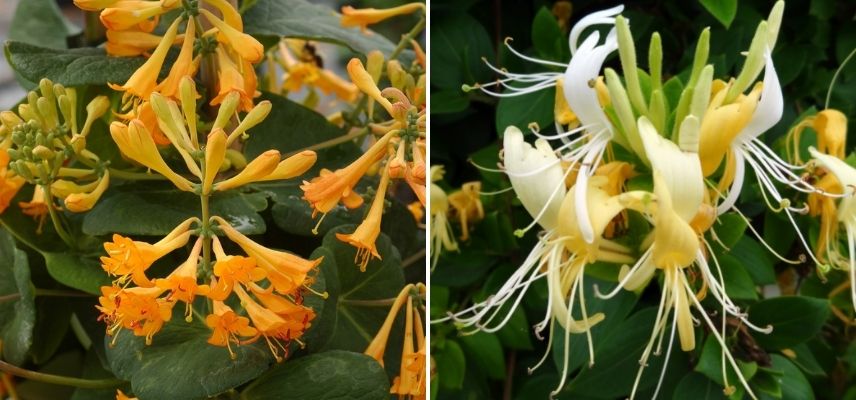
Lonicera brownii ‘Golden Trumpet’ and Lonicera japonica ‘Halliana’
With trees or bushes
Use your modest-sized trees or bushes as supports for your Honeysuckles. This combination creates an original effect while adding colour to the supporting vegetation. It’s amazing to discover a myriad of flowers on a bush that is only decorative for its leaves (Japanese Spindle, Portuguese or Caucasian Laurel, and Privet). To train a Honeysuckle up the trunk of a tree, the flexible stems of a young plant should be woven together on a stake, gradually throughout their development, so that they form a trunk after 2 years. This allows the Honeysuckle to stand upright and then invade the branches of the tree. You can choose to let your Honeysuckle climb (for example, the vigorous Lonicera similis var delavayi) on a fruit tree (plum, apple, or cherry) or an ornamental tree such as a Magnolia or Cornus kousa (‘China Girl’). On a summer-flowering bush, you can combine two different flowerings (Abelia, Deutzia, Hibiscus, Mock Orange) for a lush association.
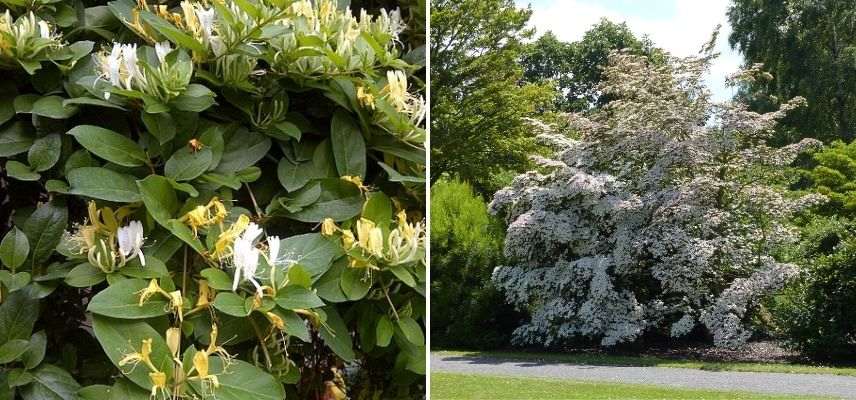
Lonicera delavayi (photo Wikipedia) and Cornus kousa
With perennials to flower a bank
Honeysuckle can also be used to cover a bank. Of course, it is usually the shrubby honeysuckles (Lonicera pileata and Lonicera nitida) that are employed in this situation. However, these have the disadvantage of not flowering. Among the climbing honeysuckles, there are some that can serve as groundcover plants, such as Lonicera japonica ‘Halliana’ in semi-shaded conditions. They can be trained as climbing plants or used to cover the ground. The numerous shades of honeysuckle flowers pair well with other groundcover plants that produce purple flowers: periwinkles or hardy geraniums. Lamium or Houttuynia cordata ‘Chameleon’ are also interesting for their decorative and colourful foliage.

Vinca minor, Lonicera ‘Caprilia Imperial’ and Lamium maculatum ‘Roseum’ (photo Wikipedia)
In a bohemian garden
With its fragrant flowers, Honeysuckle is a welcome addition to comforting bohemian gardens. It is best placed solitary on its support, allowing it to feel at ease. Opt for the most fragrant varieties, such as Lonicera periclymenum ‘Scentsation’. The Wood Honeysuckles (Lonicera periclymenum) are generally the most aromatic. Create your garden by selecting rustic and colourful plants (Aster, Gaura, Valerian, Monarda, Foxglove, Columbine). Also focus on soft-textured plants that you can’t help but touch, like the irresistible Pennisetum, Lagurus ovatus or Stachys byzantina. Flowering shrubs such as Deutzia or the Butterfly Tree integrate perfectly. Finally, also consider accessories for a “cocooning” touch without which the garden wouldn’t quite be bohemian: hammock, deck chair, blanket, cushion, fairy lights, etc…
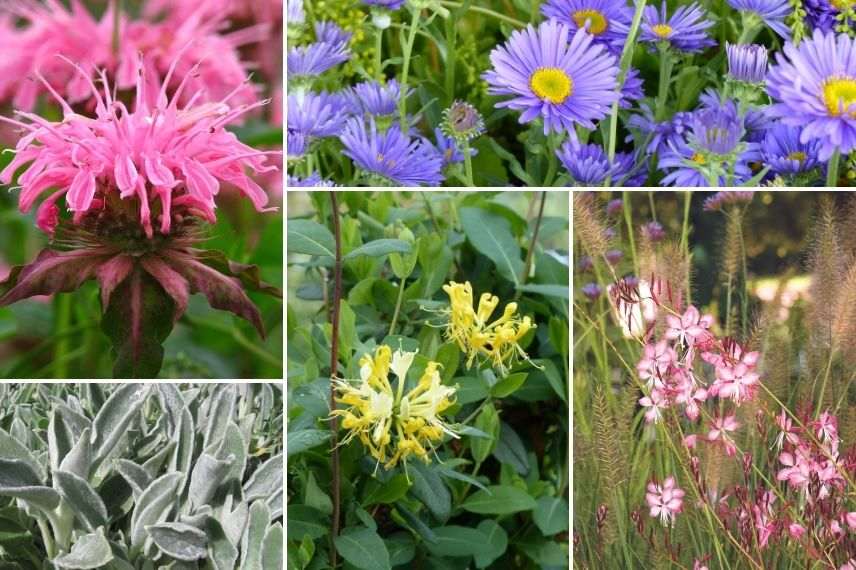
Monarda ‘Croftway Pink’ (photo Wikipedia), Aster alpinus ‘Dunkle Schöne’, Stachys byzantina (photo A_Poulos), Lonicera ‘Scentsation’ and Gaura ‘Rosy Jane’
For further reading
- Discover our complete guide on Honeysuckle: planting, pruning, and maintenance
- Find our selection of the most fragrant honeysuckles.
- Subscribe!
- Contents
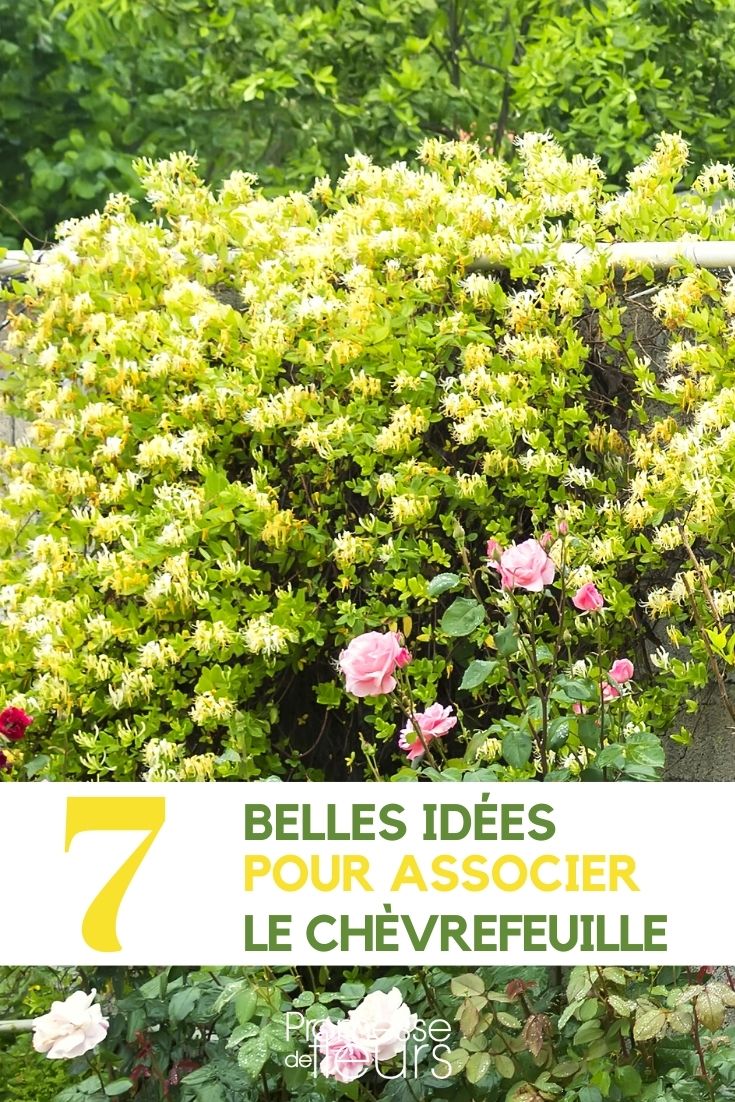































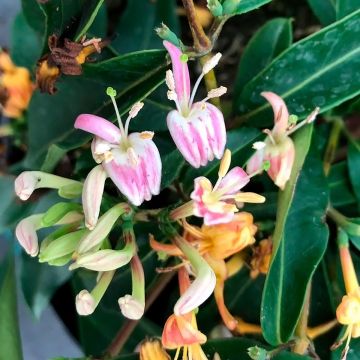
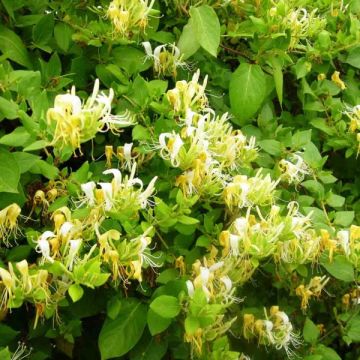
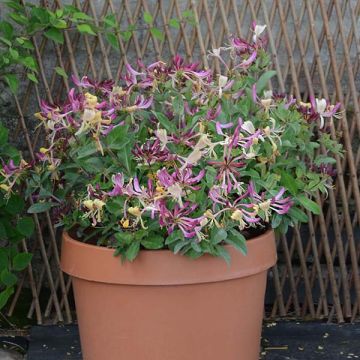
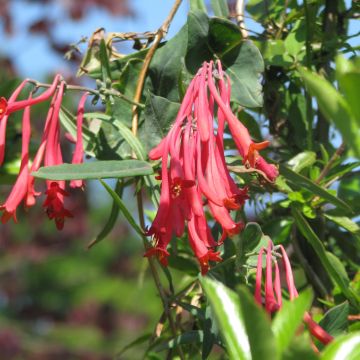
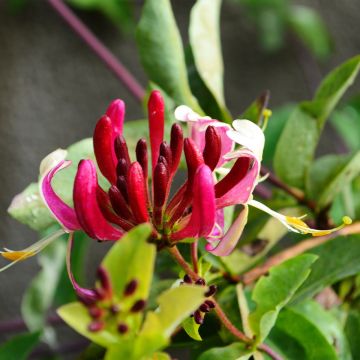
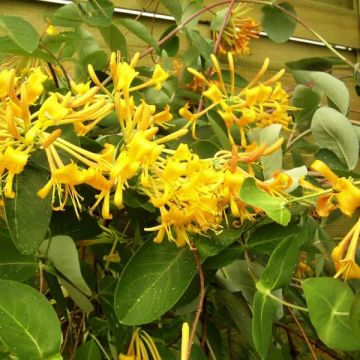
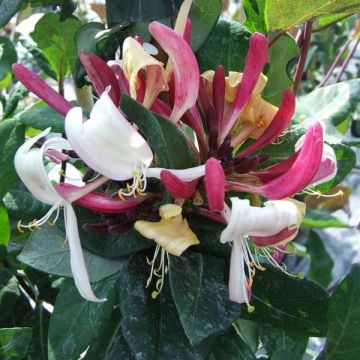
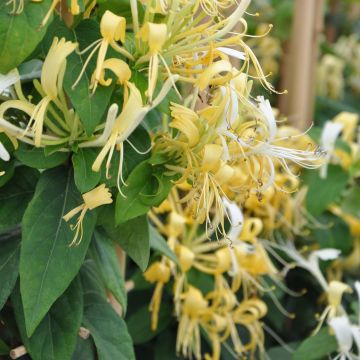
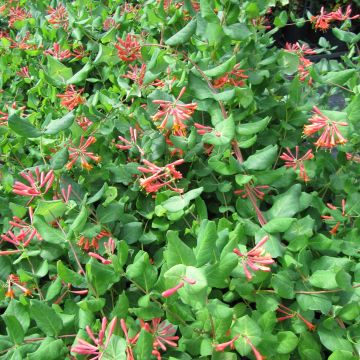

Comments